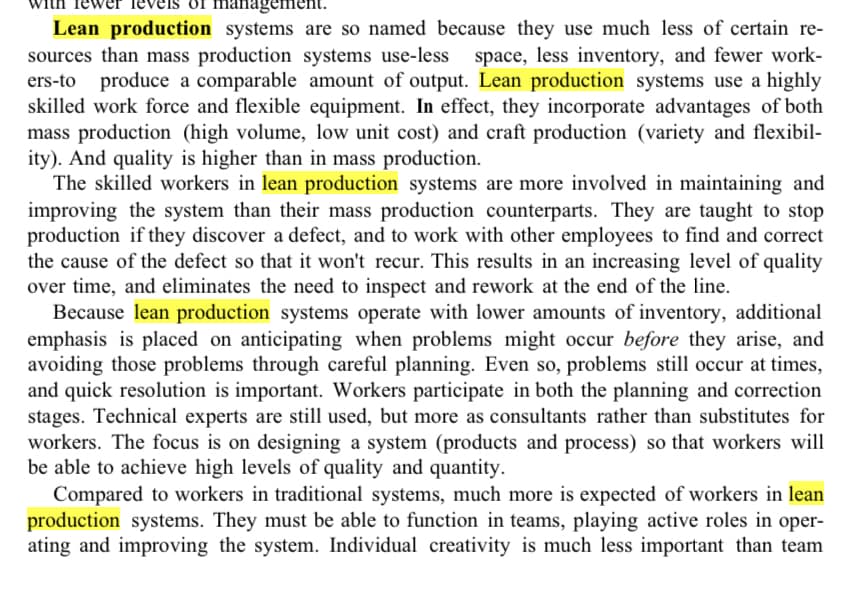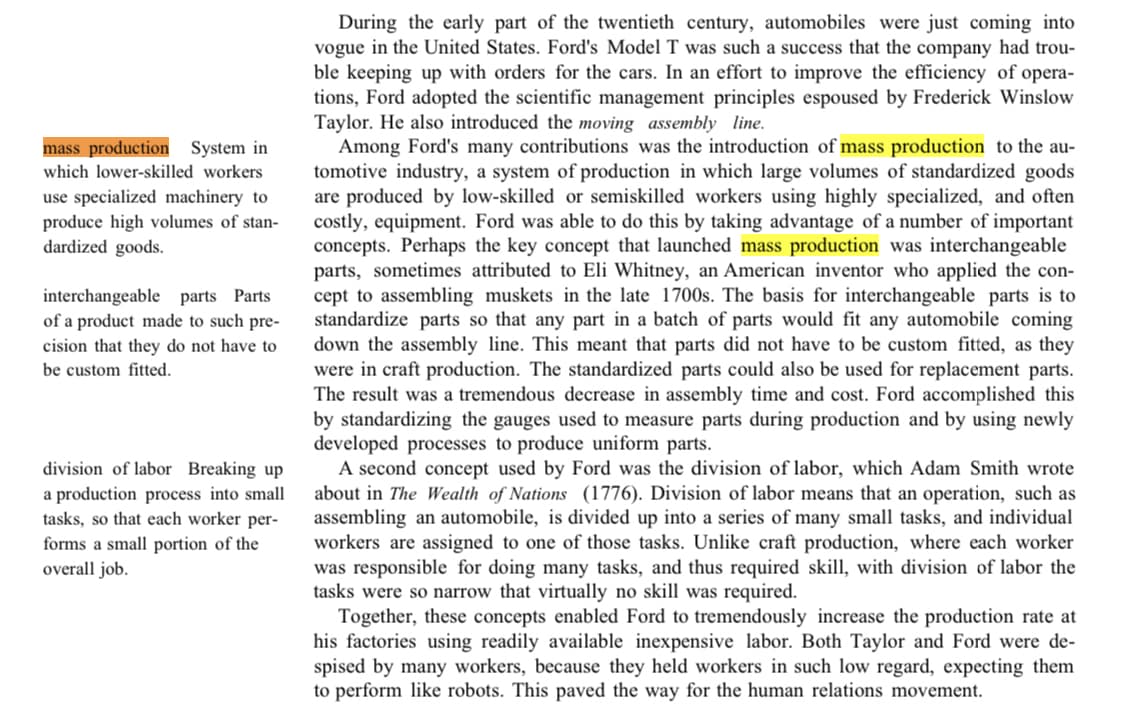Describe each of these systems: lean production and mass production
Practical Management Science
6th Edition
ISBN:9781337406659
Author:WINSTON, Wayne L.
Publisher:WINSTON, Wayne L.
Chapter2: Introduction To Spreadsheet Modeling
Section: Chapter Questions
Problem 20P: Julie James is opening a lemonade stand. She believes the fixed cost per week of running the stand...
Related questions
Question
Describe each of these systems: lean production and mass production
Important note: please refer to the given lessons on the photos attached thank you

Transcribed Image Text:nanagement.
Lean production systems are so named because they use much less of certain re-
sources than mass production systems use-less space, less inventory, and fewer work-
ers-to produce a comparable amount of output. Lean production systems use a highly
skilled work force and flexible equipment. In effect, they incorporate advantages of both
mass production (high volume, low unit cost) and craft production (variety and flexibil-
ity). And quality is higher than in mass production.
The skilled workers in lean production systems are more involved in maintaining and
improving the system than their mass production counterparts. They are taught to stop
production if they discover a defect, and to work with other employees to find and correct
the cause of the defect so that it won't recur. This results in an increasing level of quality
over time, and eliminates the need to inspect and rework at the end of the line.
Because lean production systems operate with lower amounts of inventory, additional
emphasis is placed on anticipating when problems might occur before they arise, and
avoiding those problems through careful planning. Even so, problems still occur at times,
and quick resolution is important. Workers participate in both the planning and correction
stages. Technical experts are still used, but more as consultants rather than substitutes for
workers. The focus is on designing a system (products and process) so that workers will
be able to achieve high levels of quality and quantity.
Compared to workers in traditional systems, much more is expected of workers in lean
production systems. They must be able to function in teams, playing active roles in oper-
ating and improving the system. Individual creativity is much less important than team

Transcribed Image Text:mass production System in
which lower-skilled workers
use specialized machinery to
produce high volumes of stan-
dardized goods.
interchangeable parts Parts
of a product made to such pre-
cision that they do not have to
be custom fitted.
division of labor Breaking up
a production process into small
tasks, so that each worker per-
forms a small portion of the
overall job.
During the early part of the twentieth century, automobiles were just coming into
vogue in the United States. Ford's Model T was such a success that the company had trou-
ble keeping up with orders for the cars. In an effort to improve the efficiency of opera-
tions, Ford adopted the scientific management principles espoused by Frederick Winslow
Taylor. He also introduced the moving assembly line.
Among Ford's many contributions was the introduction of mass production to the au-
tomotive industry, a system of production in which large volumes of standardized goods
are produced by low-skilled or semiskilled workers using highly specialized, and often
costly, equipment. Ford was able to do this by taking advantage of a number of important
concepts. Perhaps the key concept that launched mass production was interchangeable
parts, sometimes attributed to Eli Whitney, an American inventor who applied the con-
cept to assembling muskets in the late 1700s. The basis for interchangeable parts is to
standardize parts so that any part in a batch of parts would fit any automobile coming
down the assembly line. This meant that parts did not have to be custom fitted, as they
were in craft production. The standardized parts could also be used for replacement parts.
The result was a tremendous decrease in assembly time and cost. Ford accomplished this
by standardizing the gauges used to measure parts during production and by using newly
developed processes to produce uniform parts.
A second concept used by Ford was the division of labor, which Adam Smith wrote
about in The Wealth of Nations (1776). Division of labor means that an operation, such as
assembling an automobile, is divided up into a series of many small tasks, and individual
workers are assigned to one of those tasks. Unlike craft production, where each worker
was responsible for doing many tasks, and thus required skill, with division of labor the
tasks were so narrow that virtually no skill was required.
Together, these concepts enabled Ford to tremendously increase the production rate at
his factories using readily available inexpensive labor. Both Taylor and Ford were de-
spised by many workers, because they held workers in such low regard, expecting them
to perform like robots. This paved the way for the human relations movement.
Expert Solution
This question has been solved!
Explore an expertly crafted, step-by-step solution for a thorough understanding of key concepts.
Step by step
Solved in 2 steps

Recommended textbooks for you

Practical Management Science
Operations Management
ISBN:
9781337406659
Author:
WINSTON, Wayne L.
Publisher:
Cengage,

Operations Management
Operations Management
ISBN:
9781259667473
Author:
William J Stevenson
Publisher:
McGraw-Hill Education

Operations and Supply Chain Management (Mcgraw-hi…
Operations Management
ISBN:
9781259666100
Author:
F. Robert Jacobs, Richard B Chase
Publisher:
McGraw-Hill Education

Practical Management Science
Operations Management
ISBN:
9781337406659
Author:
WINSTON, Wayne L.
Publisher:
Cengage,

Operations Management
Operations Management
ISBN:
9781259667473
Author:
William J Stevenson
Publisher:
McGraw-Hill Education

Operations and Supply Chain Management (Mcgraw-hi…
Operations Management
ISBN:
9781259666100
Author:
F. Robert Jacobs, Richard B Chase
Publisher:
McGraw-Hill Education


Purchasing and Supply Chain Management
Operations Management
ISBN:
9781285869681
Author:
Robert M. Monczka, Robert B. Handfield, Larry C. Giunipero, James L. Patterson
Publisher:
Cengage Learning

Production and Operations Analysis, Seventh Editi…
Operations Management
ISBN:
9781478623069
Author:
Steven Nahmias, Tava Lennon Olsen
Publisher:
Waveland Press, Inc.